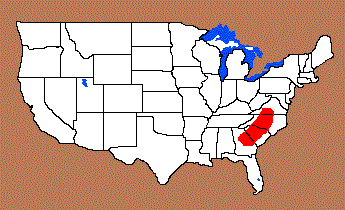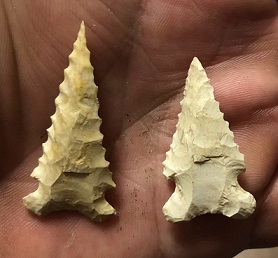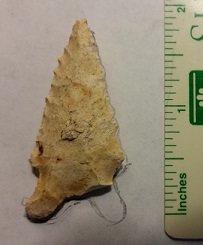Name Details:
Named By: James L. Mitchie
Named For: Type Site
Date Identified: 1966
Type Site: Van Lott Site, South
Carolina
Van Lott
Cluster:
Commonly Utilized Material:
Date:
Cultural Period:
9,900 -8,500 B.P.
Early Archaic
Early Holocene
Glacial Period:
Culture:
Outline is Representative of Common Size and Shape:
Description of Physical Characteristics and Flaking Pattern:
This is a medium triangular
side notch point with an elliptical cross section. The blade varies from excurvate to straight. The blade is commonly
serrated or beveled. Parallel notches are usually round to U-shaped. The shoulders range from horizontal to having a slightly upward angle. The stem is expanding with a concave
base with many examples having a "drooping ears" appearance. The basal edge may vary from rounded to square. This point has a basal smoothing and thinning with a random
flaking pattern.
Size Measurements: Total Length - 30 to
50 mm (average 40 mm). Stem Length - 8 to 12 mm, Blade Width
- 16 to 26 mm, Stem Width - Approx. the same as the blade or
slightly wider, Neck Width - 15 to 20 mm
Distribution:
Distribution Comments:
This point is primarily found in the Piedmont and into the foothills of the Appalachians of North Carolina and into north central Georgia and southern Virginia.

Additional Comments:
This type is similar to the Taylor Side Notch point with many references to this type hyphenated Taylor-Van Lott. The two types are commonly used synonymously with the name Taylor
being more commonly used in North Carolina and Virginia and the name Van Lott more commonly used in South Carolina. However, Mitchie identified both types and noted differences between the two types.
Loyd Doty notes:
SAN PATRICE-VAN LOTT (Auriculate) – is Spanish and means ‘of noble descent’. This variant was named by James L. Michie for examples recovered
from the Van Lott archaeological site in South Carolina. They are small (1” to 2”) projectiles and knives with sharp tips, straight or recurved blade edges and concave
bases with sharp tipped auricles. The basal areas are ground. Distribution is Virginia, North Carolina, South Carolina and they
were in use during the Early Archaic to Trans Paleo period. Reference: Michie, James L. 1977, Early Man in South Carolina. Senior Honors Thesis, Department of Anthropology,
University of South Carolina, Columbia. Manuscript on file, South Carolina Institute of Archaeology and Anthropology, Columbia, South Carolina.
Pictures:


Other points in this Cluster:
Point Validity: Valid Type
Michie was an anthropologist and
a professor at Coastal Carolina University. He served as the associate director at the Waccamaw Center for Historical and Cultural Studies. He named this type in his thesis at the University of South Carolina and has limited professional references. This is considered a
valid type.
.
Age Details:
Pictures Provided By:
DW
Joe Burns
References: (See Reference Page, Entry Number):
23, 30
Van Lott Side Notch Projectile Point, Van Lott Side Notch Arrowhead

